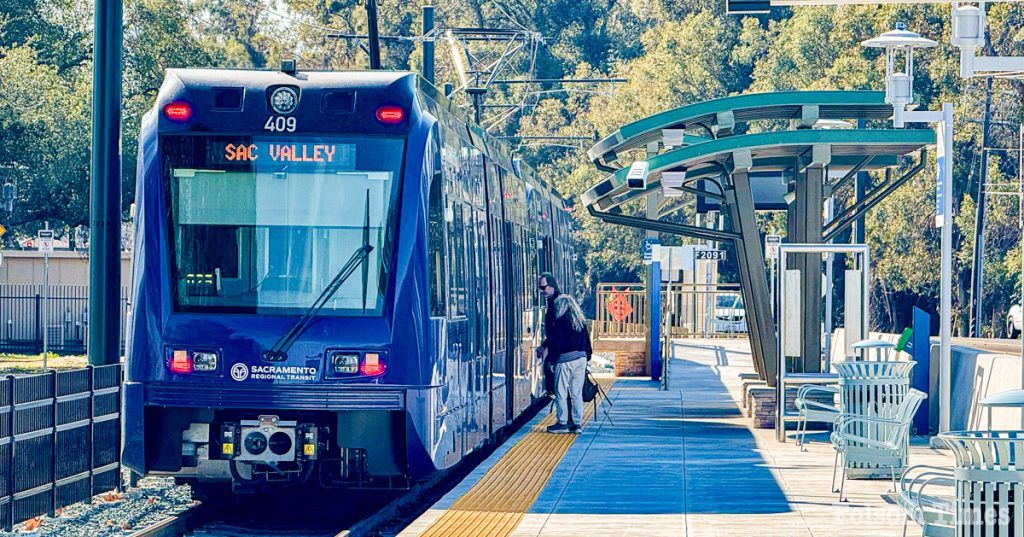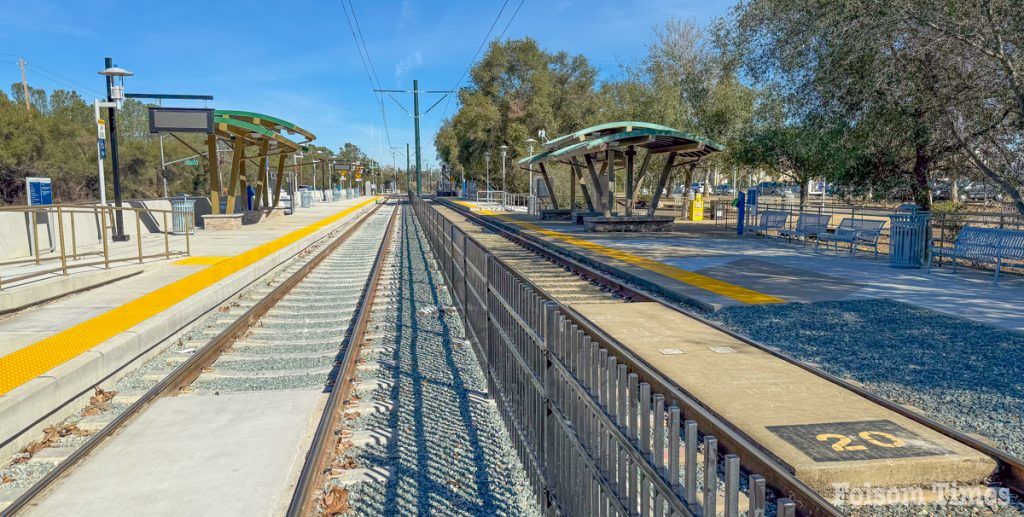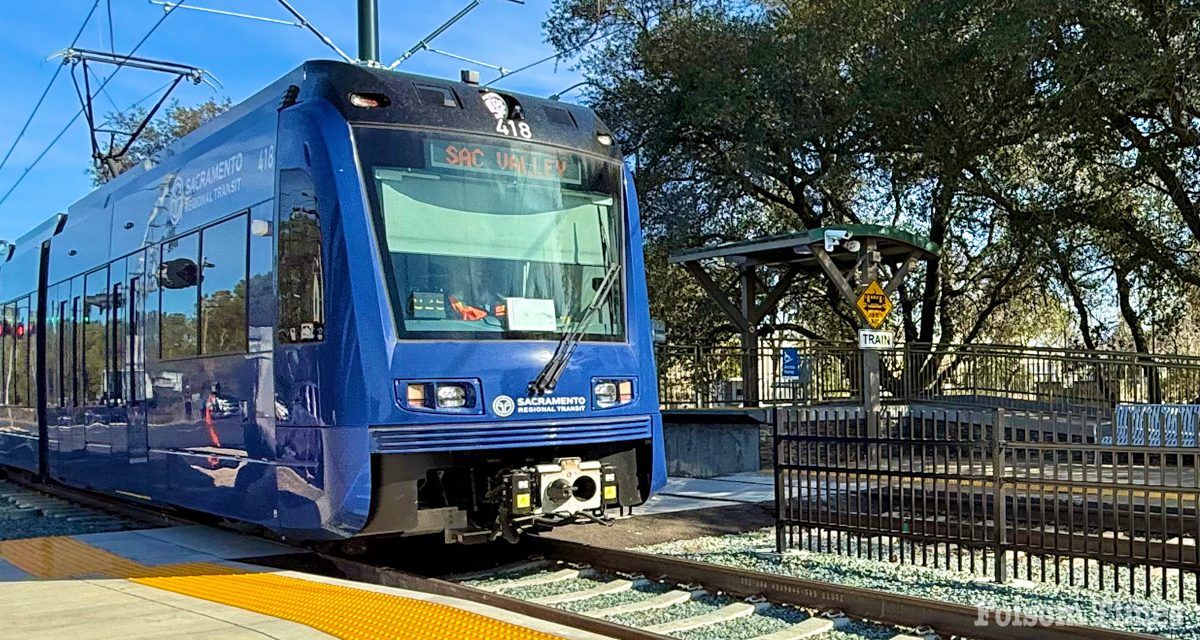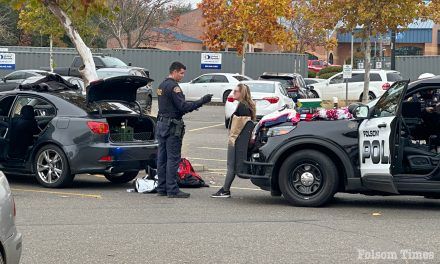SacRT focusing on fixes after challenges with new passing tracks have riders steamed
The promise of quicker commutes has derailed into daily headaches for Sacramento Regional Transit (SacRT) light rail riders in Folsom. Instead of speeding up service, the newly constructed passing tracks—part of a $36 million project completed in late December 2024—have brought anything but gold to the Gold Line, with delays, disruptions, and growing commuter frustration as SacRT scrambles to fix the issues and deliver the service they promised.
Before resuming service, SacRT had to finalize track testing and secure approval from the California Public Utilities Commission (CPUC). The new tracks were designed to allow trains to pass each other and reduce wait times from 30 minutes to 15 minutes during peak hours. According to SacRT’s original schedule, weekday trains were supposed to serve Folsom-area stations—Historic Folsom, Glenn/Robert G. Holderness, Iron Point, and Hazel—every 15 minutes from 6 a.m. to 11:30 p.m. Weekend service (Saturdays and Sundays) is scheduled for 30-minute intervals at all Folsom stations, providing riders with greater convenience and flexibility.
Despite these plans, the reality has fallen short. Jessica Gonzalez, a spokesperson for SacRT, recently acknowledged that while the system performed well during testing, it has struggled under actual operational conditions. A major issue is trains getting stuck in downtown Sacramento traffic, which then causes delays at the crucial Folsom passing track. “If we get backed up in downtown and the trains can’t be in the correct spot to pass each other at that passing track, that could cause a delay,” Gonzalez explained.
Adding to the problems, state inspectors found that the crossing arms at the Glenn/Robert G. Holderness Station did not meet CPUC standards, falling short of a 12-foot clearance requirement. The finding requires them to implement a slow order for trains traveling through this section, ultimately forcing them to stop twice at the same location. SacRT stated that the contractor who installed the crossing arms incorrectly is responsible for both the error and the cost of correcting it. “It’s unfortunate,” Gonzalez said. “It obviously slows down the trains to have to do that double stop at that station.”

SacRT has confirmed that the contractor is responsible for the cost and correction of the issue, which is due to be completed by April. “We’re working on a number of solutions to get those trains running on time, but it’s a challenge,” Gonzalez added. To improve the rider experience, SacRT has enhanced its real-time notifications to keep passengers better informed about service delays. However, the alerts don’t change the fact that the issues put a strain on riders who rely on the schedule for commuting to and from work and other obligations.
Folsom City Councilmember Anna Rohrbough, appointed to represent Folsom on the Sacramento Regional Transit Board on Jan. 13, has also heard from several residents about their frustrations. “I have already had many requests from residents for information about delays and solutions to the issues they are facing since the 15-minute rollout occurred in early January,” Rohrbough shared. “SacRT staff has been responsive to my concerns and most recently presented at the Jan. 27 board meeting regarding the Folsom 15-minute train. It is clear to me that they are continually working on solutions to the timing and customer service problems that have emerged. I do feel confident things will only keep improving as we go forward.”
Rohrbough encourages residents to continue reaching out to her as well as SacRT with concerns as solutions are sought. She also offered insight into the challenges SacRT faces and why service has been inconsistent. She shared that the original plan was to have two double-tracking sites—at Glenn and Hazel stations—to allow more flexibility for trains to pass each other.
“However, with limited funding, SacRT was only able to secure funding for one double-tracking site at the Glenn station. SacRT tried to operate the 15-minute service to meet community needs, which allows only a two-minute window for trains to pass through,” she added. “This requires precision and perfection in theory. However, in the real world, if a car blocks a track downtown, it makes it impossible to maintain 15-minute service and raises safety concerns. Since safety is a top concern, SacRT has been exploring a wide variety of ways to maintain on-time service safely. As a board member, I will continue to ask them to be innovative and seek optimal solutions for our community.”
One of the many residents who have reached out to Rohrbough and others is Mike Novak. Using the light rail to commute on a daily basis, Novak has been a victim of the “train turnaround” numerous times. He has engaged in lengthy email conversations with SacRT and Rohrbough, urging them to prioritize fixing the issues, not only for himself but for all involved.
“The 15-minute service is great, but the rollout is atrocious. Every morning, the trains are 20 minutes late, and on the ride home this afternoon, they switched it back to a Sunrise train, and everyone had to get off. There were months of testing the passing track, and you would think they just started using it yesterday,” said a frustrated Novak. “Things happen, I get it, but none of these delays or changes are announced over the app. The messaging needs to be fixed, and RT needs to explain what’s going on.”
As Gonzalez mentioned, SacRT has put additional alerts into place for riders, but the delays continue to frustrate commuters. The lack of punctuality and, oftentimes, very crowded train cars when riders are offloaded and reloaded to another train add to travelers’ frustrations.
“People have to physically force themselves into the crowd at each stop. Many people are left on the platform each time. RT is failing to service the Gold Line, and the board and staff aren’t understanding the depth of the issues,” added Novak.
Alex Levin is another frustrated rider who has continually reached out to SacRT staff and local media to share his concerns and ask for solutions.
“Today, as my outbound train was again disembarked at Sunrise with no service alerts, my train operator confirmed to me that the 15-minute service remains essentially a mirage,” Levin shared in an email. “There are daily delays, service stops, bus bridges, etc., between Historic Folsom and Sunrise. There has seemingly been no messaging beyond ad hoc service alerts treating each instance in isolation.”
SacRT has responded promptly to Levin regarding his concerns, which he acknowledged, but the delays continue to frustrate him. “Everyone on the platform is describing the real and significant daily adverse impacts on their jobs, productivity, etc.,” wrote Levin. “Missed work, $40 Ubers, etc.”

SacRT board representative Rohrbough shared details from SacRT about current operational adjustments, which result in every fourth train turning around at Sunrise Station to help manage traffic and reduce delays. The first scheduled turnaround occurs at 6:20 a.m. at Sunrise Station, with every fourth train turning around at :20 past the hour throughout the day. The train that turns around at Sunrise at 6:20 a.m. is scheduled to depart Historic Folsom at 6:44 a.m. inbound. This results in 13 out of 65 daily trips turning around at Sunrise, creating 30-minute service between Sunrise and Historic Folsom for those trips. All other trips continue on a 15-minute schedule.
During peak hours (6–9 a.m. and 3–6 p.m.), outbound trains from Sunrise to Historic Folsom turning around at 6:20 a.m., 7:20 a.m., 8:20 a.m., 3:20 p.m., 4:20 p.m., and 5:20 p.m. will create 30-minute service instead of 15-minute service. Inbound trains from Historic Folsom to Sunrise departing at 6:44 a.m., 7:44 a.m., 8:44 a.m., 3:44 p.m., 4:44 p.m., and 5:44 p.m. will also result in 30-minute service. All other trips will continue running every 15 minutes, according to the updates Rohrbough shared.
SacRT reports that approximately 80 percent of trips will continue to operate as scheduled. However, during peak hours, 66.7 percent of peak-hour trains will run on time, with the remaining 33.3 percent affected by the Sunrise turnaround.
Riders can submit their questions and concerns through SacRT’s website at www.sacRT.com. Folsom City Councilmember Anna Rohrbough can be contacted through her Folsom City Council email at annar@folsom.ca.us.




